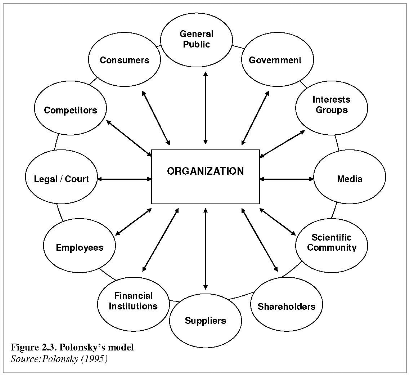2.4. Stakeholders' management - Polonsky's model

According to Polonsky's model (1995) above, stakeholders not
only have a stake in the organizational behaviour but they are also linked to
each other. To make the figure easiest to read, all the links between
stakeholders are not shown, but they are implied. Any group may have
connections with each other group. It is based on Freeman (1984) stakeholders'
selection, as it keeps the same twelve important groups.
According to Polonsky, there is a four-step-management-process
to integrate the stakeholders in the strategy developing process:
1 Identify the relevant stakeholder groups.
2 Determine the stake and importance of each stakeholder group.
1 Determine how effectively the «needs» or
«expectations» of each group is being met.
2 Modify corporate policies and priorities to take into
consideration stakeholder interests.

Stage 1: stakeholder identification The organization has
to draw a stakeholder map (Mendelow and Archer's models will be useful for this
task!). If you analyse stakeholders for a specific issue, then the map may
differ from the one you drawn just before. Maps also changes with stakeholders
repositioning and depends on stakeholders' relationship between them as well.
To determine which stakeholder groups are relevant, the author suggests the
organization to consider how they relate to the strategy implementation. If the
group may influence the firm's strategy, it is a relevant one. The organization
has to be sure that its analysis considers the key factors to its strategy.
Stage 2: determining the stakes Managers must determine
each stockholder's stake; this is a very difficult task. These groups have
different effects on different part of the organization, and do not perceive
the organization's behaviour the same way. Sometimes interactions between
stakeholders may be more important than their direct effect on the firm. An
accurate determination of stakes is an essential step of the strategy
development project. According to Freeman (1984), each stakeholder can
potentially have a positive or negative influence on the organization, that's
why it is very important for the firm to forecast the stakeholders'
expectations evolution. There is no clear method to determine these stakes but
direct communication with those groups allows the organization to have an
unbiased feedback about how it is perceived. Unfortunately, organizations are
sometimes in unfavourable terms with some stakeholders. A good understanding of
the stakes and potential of each stakeholder's group may have on the firm a
valuable effect on the development of an optimal strategy.
Stage 3: Determine how well expectations are met Once the
stakeholders' expectations are determined (cf. stage 2), the organization has
to know if these hopes are met with the current strategy. It is also a
difficult task because some objective can be concrete and measurable, but it is
easy to analyse if an effort has been put in place to improve this kind of
issue. But some stakeholders' groups have subjective aims, so the organization
must understand them as clearly as possible. If there is no good understanding
about an issue, both stakeholders and organization will view each other as an
adversary. Usually, managers realize the gap between its strategy and
stakeholders' expectations after a clash, a strike... Polonsky (1995) suggests
that the organization continually conducts social audits; without it, it would
be difficult to

How stakeholders influence football clubs' strategy ? September
2003
minimize gaps. Moreover, these audits will be used as a
monitoring tool in the time, because a satisfied unimportant stakeholder of
today may be an unsatisfied and important one in the future. This cannot be
determined without those social audits. Direct communication is, again, the
most effective way to socialize stakeholders into the organization. According
to Polonsky (1995), the lack of communication often distorts the manager's
interpretations of the stakeholders' expectations as well as the stakeholders'
understanding of organizational behaviour.
Stage 4: Adjusting the organization's strategy After
managers determined how well stakeholders' expectations are being met by the
current strategy, they have to adapt and reformulate their corporate strategy
(most of times, strategy is not adapted enough to stakeholders). This strategy
has to integrate competing expectations with organizational priorities. So, it
is improbable that the new strategy meets all expectations at once. In these
cases, Polonsky (1995) suggests that managers develop programs or contingency
plans for potential problems that may arise in the future. The problem for
managers is now to decide which stakeholders' expectations will and will not be
met. The information collected in the precedent stages is the best tool to make
this difficult but necessary decision. An alternative solution is that the
organization and stakeholders' groups interaction may change groups'
expectations, but it is unlikely that all groups change their objectives and
agree with the new strategy. What usually happens is that the firm will modify
its strategy and the stakeholders modify their expectations, so that the gap
between performance and expectations is reduced. Gaps still remain and it is
the managers' role to reduce the potential for negative stakeholders'
expectations and to increase the probability of positive reactions. The key
method is, again, to do this through socialization of stakeholders into the
organization so that they will have a better understand of the organizational
objectives and therefore they should be less problematic.
| 


